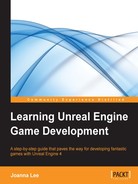In this chapter, we will learn in detail about the materials and the lights in Unreal Engine 4. We have grouped both Material and Light together in this chapter because how an object looks is largely determined by both—material and lighting.
Material is what we apply to the surface of an object and it affects how the object looks in the game. Material/Shader programming is a hot ongoing research topic as we always strive to improve the texture performance—seeking higher graphic details/realism/quality with limited CPU/GPU rendering power. Researchers in this area need to find ways to make the models we have in a game look as real as possible, with as little calculations/data size as possible.
Lighting is also a very powerful tool in world creation. There are many uses of light. Lights can create a mood for the level. When effectively used, it can be used to focus attention on objects in the level and guide players through your level. Light also creates shadow. In a game level, shadow needs to be created artificially. Hence, we will also learn how we get shadows rendered appropriately for our game.
In the previous chapter, we briefly touched on what a material is and what a texture is. A texture is like a simple image file in the format of .png/.tga. A material is a combination of different elements, including textures to create a surface property that we apply to our objects in the game. We have also briefly covered what UV coordinates are and how we use them to apply a 2D texture to the surface of a 3D object.
So far, we have only learned how to apply materials that are available in the default Unreal Engine. In this chapter, we will dive deeper into how we can actually create our own custom material in Unreal Engine 4. Fundamentally, the material creation for the objects falls into the scope of an artist. For special customized textures, they are sometimes hand painted by 2D artists using tools such as Photoshop or taken from photographs of textures from the exact objects we want, or similar objects. Textures can also be tweaked from existing texture collection to create the customized material that is needed for the 3D models. Due to the vast number of realistic textures needed, textures are sometimes also generated algorithmically by the programmers to allow more control over its final look. This is also an important research area for the advancing materials for computer graphics.
Material manipulation here falls under the scope of a specialized group of programmers known as graphic programmers. They are sometimes also researchers that look into ways to better compress texture, improve rendering performance, and create special dynamic material manipulation.
